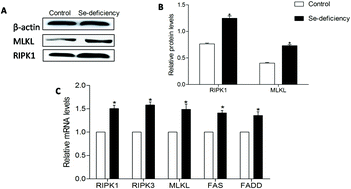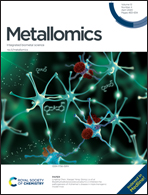The role of necroptosis and apoptosis through the oxidative stress pathway in the liver of selenium-deficient swine
Abstract
Necroptosis is regarded as a new paradigm of cell death that plays a key role in the liver damage observed with selenium (Se) deficiency. Se deficiency has a significant impact on the livestock and poultry industries. Previous studies have confirmed that Se deficiency causes serious injury to the swine liver; however, it is unclear whether this liver damage is the result of necroptosis and apoptosis. To understand the damage induced by Se deficiency, swine were divided into a control group and Se-deficient group. The results showed that in the liver of swine, Se deficiency initiated apoptosis by increasing the expression of cysteinyl aspartate specific proteinase 3 (caspase-3), cysteinyl aspartate specific proteinase 9 (caspase-9) and BCL-2 antagonist/killer (BAK) at both the mRNA and protein levels and by decreasing the B cell lymphoma/leukemia 2 (BCL-2) levels compared with the levels in the control group. Meanwhile, compared with the control group, necroptosis was confirmed in the liver of Se-deficient swine through increased the expression of mixed lineage kinase domain like pseudokinase (MLKL) and receptor interacting serine/threonine kinase 1 (RIPK1) at both the mRNA and protein levels. In addition, the activities of catalase (CAT), nitric oxide (NO), and total antioxidative capacity (T-AOC) were clearly increased (P < 0.05), and the activities of OH- and total nitric oxide synthase (TNOS) were obviously decreased (P < 0.05), whereas in the Se-deficient group, the hydrogen peroxide (H2O2) and malondialdehyde (MDA) levels were obviously increased (P < 0.05) compared with those in the control group. Moreover, the number of apoptotic cells was increased significantly in the Se-deficient group, and the liver tissues showed obvious necroptosis damage. These results show that Se deficiency induces apoptosis and necroptosis through the oxidative stress pathway in the swine liver.



 Please wait while we load your content...
Please wait while we load your content...